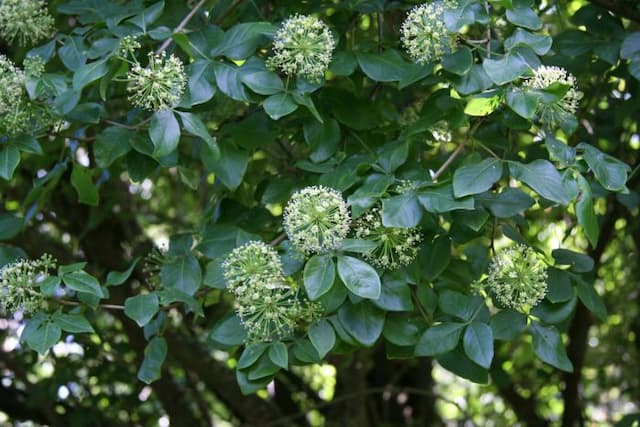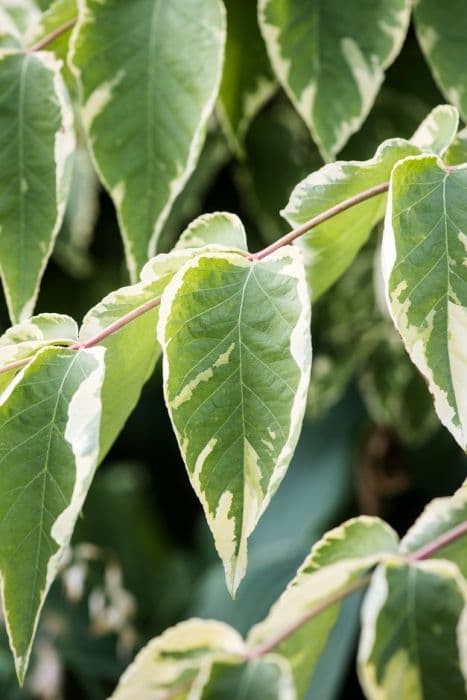Algerian Ivy Hedera algeriensis 'Gloire de Marengo' (v)

ABOUT
The plant commonly known as Algerian ivy 'Gloire de Marengo' presents itself with a vibrant appearance that includes variegated leaves. The foliage of this cultivar displays a prominent color pattern, typically presenting a green center with white to creamy-white edges, sometimes with hues of grayish-green. The leaves are heart-shaped and have a glossy texture, adding a lush and shiny aspect to the plant. This glossy effect on the leaves contributes to the visual appeal of Algerian ivy, making it a popular choice for indoor and outdoor ornamental use. The variegation pattern can add an eye-catching contrast to garden greenery or interior spaces.
About this plant
 Names
NamesSynonyms
Algerian Ivy, Canary Island Ivy, Variegated Algerian Ivy, Gloire de Marengo Ivy.
Common names
Hedera canariensis var. algeriensis 'Gloire de Marengo', Hedera algeriensis 'Variegata', Hedera canariensis 'Gloire de Marengo'
 Toxicity
ToxicityTo humans
The Algerian ivy is considered toxic if ingested due to its saponins content. If parts of the plant are eaten, symptoms may include abdominal pain, vomiting, and diarrhea. In severe cases, difficulty in breathing, fever, polydipsia, increased salivation, dilated pupils, and convulsions could occur. Touching the plant may also cause dermatitis in sensitive individuals.
To pets
Algerian ivy is toxic to pets, including cats and dogs, due to the saponins present in the plant. If ingested, pets may exhibit symptoms such as vomiting, abdominal pain, hypersalivation, and diarrhea. In severe cases, intake can lead to more serious symptoms like ataxia, difficulty in breathing, and occasionally convulsions. Additionally, the plant can cause skin irritation upon contact.
 Characteristics
CharacteristicsLife cycle
Perennials
Foliage type
Evergreen
Color of leaves
Variegated
Height
6-8 feet (1.8-2.4 meters)
Spread
3-5 feet (0.9-1.5 meters)
Plant type
Climber
Hardiness zones
7-11
Native area
North Africa
Benefits
 General Benefits
General Benefits- Ornamental Appeal: The Variegated Algerian Ivy has attractive, glossy, variegated leaves that can add color and visual interest to gardens, walls, and fences.
- Versatility: This plant can be used in a variety of settings such as ground cover, container gardens, or as a climbing vine on trellises and walls.
- Growth Habit: It has a vigorous growth habit, quickly covering large areas, which can be useful for landscaping projects that require fast coverage.
- Low Maintenance: Once established, it requires minimal care, making it ideal for gardeners of all skill levels.
- Drought Tolerance: It is relatively drought-tolerant, which is beneficial for regions with water restrictions or less frequent rainfall.
- Shade Tolerance: The plant thrives in both sun and shade, providing flexibility in garden design and planting locations.
- Erosion Control: The ivy's dense growth can help prevent soil erosion on slopes and banks.
- Year-Round Interest: Its evergreen foliage provides color and interest throughout all seasons, especially in temperate climates.
 Medical Properties
Medical PropertiesThis plant is not used for medical purposes.
 Air-purifying Qualities
Air-purifying QualitiesThis plant is not specifically known for air purifying qualities.
 Other Uses
Other Uses- Variegated Algerian Ivy can be used as a backdrop in terrarium or vivarium setups, providing a lush, green setting that helps mimic the natural environment of reptiles and amphibians.
- The dense foliage of Algerian Ivy is sometimes used in film and theater productions to create realistic outdoor scenes or to camouflage equipment and set pieces.
- Artists and crafters might use the leaves of Algerian Ivy as a natural stencil or stamp in their work for creating patterns or adding a touch of nature to their designs.
- Algerian Ivy can be trained to grow over wire frames to create living sculptures or topiaries in gardens and parks for aesthetic displays.
- In photography, the leaves of the Algerian Ivy can be employed as a green motif or background to enhance the composition of still-life or product photographs.
- Algerian Ivy can be woven into natural wreaths and garlands for home decor or special events like weddings for a rustic and organic feel.
- Educational resources might use Algerian Ivy to teach botany or horticulture principles, such as plant growth habits, propagation, and maintenance.
- Some people use fallen Algerian Ivy leaves for composting, adding valuable nutrients back into the garden soil.
- Fashion designers occasionally incorporate elements of nature such as Algerian Ivy leaves into their designs or runway shows for an avant-garde or Earth-inspired look.
- Algerian Ivy can be used in landscape designing to create patterns or 'green' artwork on walls and fences, utilizing its climbing ability for visual interest.
Interesting Facts
 Feng Shui
Feng ShuiAlgerian Ivy, owing to its evergreen nature and vigorous growth, is often used in Feng Shui to introduce vibrant energy and promote growth. It can be placed in the East area of a space to encourage health and family harmony or in the Southeast to attract wealth and abundance.
 Zodiac Sign Compitability
Zodiac Sign CompitabilityAlgerian Ivy is not used in astrology practice.
 Plant Symbolism
Plant Symbolism- Friendship: Algerian ivy is often associated with friendship due to its clinging nature, symbolizing the close bonds with our friends who support us through life.
- Dependability: The plant is a hardy and evergreen climber, representing the quality of dependability and consistency in relationships or one's actions.
- Eternal life: Being evergreen, Algerian ivy can symbolize longevity and eternal life as it remains green throughout the year, regardless of the season.
- Fidelity: Algerian ivy is commonly used in wedding florals and decorations as it signifies faithfulness and attachment, reflecting the commitment in a marriage.
- Protection: With its dense growth habit, Algerian ivy symbolizes a protective embrace, suggesting shelter and safety to those surrounded by it.
 Water
WaterAlgerian Ivy 'Gloire de Marengo' prefers consistent moisture but does not tolerate standing water. Water the plant thoroughly once the top inch of soil feels dry to the touch, which typically means watering every 7 to 10 days, although this can vary depending on temperature and humidity. Each watering session should thoroughly saturate the soil, using approximately 1 to 1.5 gallons of water for larger pots or less for smaller pots, allowing any excess to drain away. During the winter months, watering should be reduced as the plant's growth slows down. Always adjust watering frequency based on the actual moisture level of the soil to prevent overwatering.
 Light
LightAlgerian Ivy 'Gloire de Marengo' thrives in bright, indirect light but can adapt to medium light conditions as well. It should be placed in a location where it's protected from direct afternoon sun to prevent leaf burn. A north or east-facing window can provide the ideal lighting conditions, offering a good balance of light without the harsh intensity of direct sun exposure.
 Temperature
TemperatureAlgerian Ivy 'Gloire de Marengo' prefers temperatures between 50 to 80 degrees Fahrenheit for optimal growth. It can tolerate a minimum indoor temperature of about 50 degrees Fahrenheit during the winter months but should be protected from drafts and sudden temperature changes. The plant can withstand temperatures up to about 90 degrees Fahrenheit during the summer, but it's important to ensure adequate humidity and watering to prevent stress.
 Pruning
PruningPruning Algerian Ivy 'Gloire de Marengo' is mainly done to maintain shape, control size, and encourage bushier growth. It should be pruned in the spring or early summer when the plant is actively growing. Pruning can be done every few months or as needed to remove any dead or damaged leaves and stems. Use sharp, clean pruning shears to make precise cuts, which helps the plant recover quickly.
 Cleaning
CleaningAs needed
 Soil
SoilAlgerian Ivy 'Gloire de Marengo' thrives in a well-draining soil mix composed of two parts peat or coco coir, one part perlite, and one part loamy garden soil. The best pH range for this plant is slightly acidic to slightly alkaline (pH 6.0 to 7.5).
 Repotting
RepottingAlgerian Ivy 'Gloire de Marengo' should be repotted every two to three years or when the plant becomes root-bound and the health of the plant indicates it's necessary.
 Humidity & Misting
Humidity & MistingAlgerian Ivy 'Gloire de Marengo' prefers moderate to high humidity levels, ideally around 40-50%. However, it can adapt to lower humidity levels typical of indoor environments.
 Suitable locations
Suitable locationsIndoor
Position Algerian Ivy in bright, indirect light, away from drafts.
Outdoor
Plant in partial shade to full shade; shelter from intense sun.
Hardiness zone
7b-11 USDA
 Life cycle
Life cycleAlgerian ivy 'Gloire de Marengo' starts its life cycle from seed germination or more typically from cuttings, where it develops roots and shoots in a suitable substrate. The juvenile phase features fast-growing vines with heart-shaped, variegated leaves that can cling to surfaces with aerial rootlets. As it matures, the plant spreads horizontally and vertically, exhibiting its lush foliage and becoming a dense ground cover or climbing vine. During this time, it may produce small, inconspicuous flowers if conditions are favorable, typically in the late summer to fall. Following flowering, it can develop blackberry-like fruits, which are not commonly seen in cultivated environments and can be harmful if ingested. After years of growth, Algerian ivy may enter a senescence stage, where growth slows and parts of the plant may die back, depending on environmental conditions and care.
 Propogation
PropogationPropogation time
Spring to Summer
Algerian ivy 'Gloire de Marengo', which is a variegated type of Hedera algeriensis, is commonly propagated through stem cuttings. The best time for taking cuttings is during the warmer months, typically late spring through early summer. To propagate, a healthy stem segment with several leaves is cut, ideally a 4 to 6 inch long cutting (10 to 15 cm). The lower leaves are removed, and the cut end is dipped in rooting hormone to encourage root development. The cutting is then inserted into a pot filled with a well-draining soil mix, ensuring at least one node is buried where roots can form. The soil should be kept consistently moist but not waterlogged, and the pot is placed in bright, indirect light. Roots should begin to form within a few weeks, after which the young ivy can be transferred to its permanent location.









